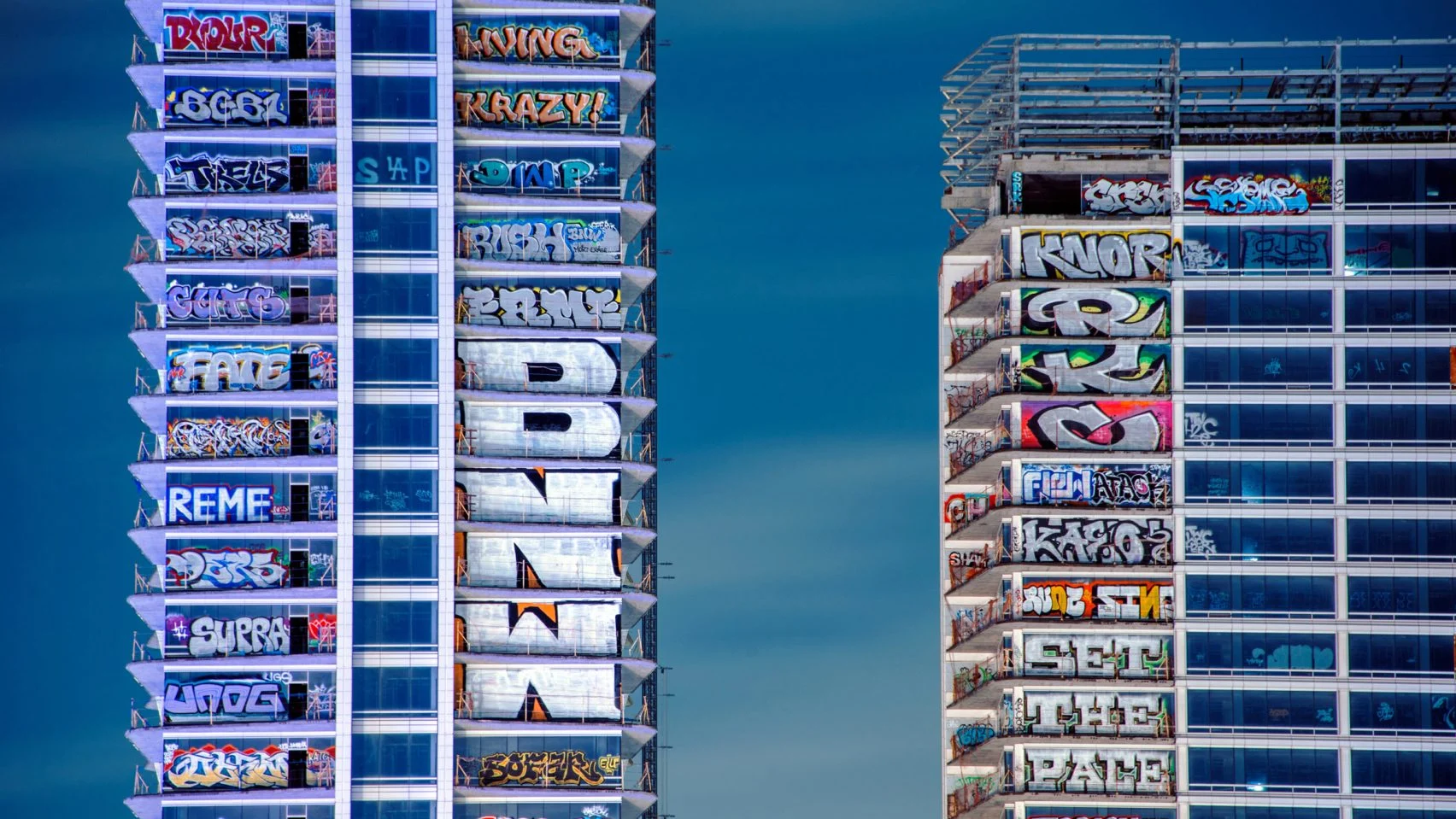Oceanwide Towers Concrete Poetry

In mid-January 2024 a growing number of graffiti artists began working on an abandoned apartment tower complex in downtown Los Angeles. The complex, Oceanwide Plaza, is located directly across from the Crypto.com Arena and gained attention just before the 66th Annual Grammy Awards. The lot was once slated to include a five-star hotel, 500 luxury apartments and a large open-air shopping mall, but Beijing-based developer, Oceanwide Holdings, halted construction after bankruptcy. Oceanwide Holdings additionally failed to pay a privately hired security team, leaving the building functionally unguarded and abandoned. Artists took this opportunity to fill the empty space. Images and drone footage began to circulate across social media highlighting the heights and sometimes dangers artists had gone to put their work up. The city government is now proposing to spend $3.8M for clean-up and security, but so far there is no word about the ultimate fate of the building.
The Oceanwide towers display the work of a number of graffiti artists on the exterior of the building. These towers provide a unique support compared to graffitied buildings like 5 Pointz in New York City or VITAS Healthcare in Miami, which are not nearly as tall or modern in design. Graffiti to the public may be associated with an area being in decline or even in a state of decomposition. Older buildings are left to rot and graffiti may begin to cover and expand outward over time as the building sits abandoned. Oceanwide with its floor to ceiling windows has a comparatively shiny and clean look. When abandoned, the buildings were still in the process of being constructed leaving various ways on to the operational scaffolding. Most of the pieces have a particular scale based on the height of each floor and the width of the window panes. In this way, the works are given a certain frame and structure based on the architecture of the buildings. Artists use numerous different colors, letter styles, alternative spellings and stylized language.
The scaffolding access, window architecture, and relative newness all give the graffiti on Oceanwide Towers a unique quality. As a whole, the regularity of the placement of the lettering brings to mind poetry. It feels as though the towers can be read from top to bottom, right to left. The meaning becomes absurd but suggestive: small moments of clarity are found in the muddle of the words. Some things stand out starkly in their vibrance and readability like FOREVER LIVING KRAZY! and SET THE PACE. The unfilled spots between window compositions offer a sort of punctuation. The layout and this implied punctuation gives the feeling that you could read a sentence. The meaning however lies in the discrete works of each artist that the community refers to as fill-ins, throwies, or pieces.
Each artist doesn’t use the window cells in the same manner. Some sections are notable based on how they use the window space vertically. For example, a section from the top of a tower reads SAUTESAUTE, one letter is placed on each floor and can be read downwards like an acrostic poem. Each letter of this piece leads into a window pane filled in by a different artist. Yet another artist alters the window pane form by rendering BNW across 6 floors, each floor is used to measure half a letter. Down one small back wall section appears a panda over and over that operates similarly to an emoji. The lines of each floor are punctuated at a right angle with its smiling animal face.
One stacked section reads:
RE☐URE
HNDO☐DEEP
PORQ☐UE
CIZM☐ANDI
Small meanings feel like they can be gleaned while simultaneously anything coherent is just out of reach. It’s hard to look at language and not attempt to make sense of it. Logically these artists are not creating a cogent piece of writing by working together. However, there are ways that the imposed order of the facade creates a legibility to the buildings that leave the impression of it being one work. The visual density makes it so the tower complex can be taken in as a whole.
The towers form what can be viewed as participatory art without any centralized planning. The buildings being abandoned presents the context for the artists. What is unexpected is the aesthetic regularity; there is a clarity to the layout that gives the feeling of order although graffiti is seen as a chaotic act. Despite the danger, disorder and disregard for authority the work taken together has a formal discipline. The buildings become an installation of concrete poetry.
Written by
eastofborneo class
Photo credit Kelvin Cheng